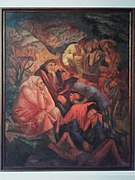Boychukism
Early 20th century Ukrainian art style From Wikipedia, the free encyclopedia
Boychukism is a cultural and artistic phenomenon in the history of Ukrainian art of 1910–1930s, distinguished by its artistic monumental-synthetic style.[1]

The basis of Boychuk's concept of the development of new art was an appeal to the traditions of Byzantine and Italian monumental painting, as well as middle-age Rus' icon painting, as the primary source of the Ukrainian national form.
The name comes from the name of the founder of the movement: Mykhailo Boychuk, a muralist and graphic artist. Boychuk, as well as several other artists, made Soviet propaganda and promoted communism. However, Boychuk was labelled as a "bourgeois nationalist" by Joseph Stalin, and he was executed.[2]
At the end of 1925, the Association of Revolutionary Art of Ukraine (ARIU) was founded in Kyiv, uniting Boychukists.[3]
Gallery
- Shevchenko holiday, Mikhail Boychuk, 1920
- M. Padalka. Sketch of an illustration for “The Tale of Igor’s Campaign,” 1928.
- Sedlyar, Vasily Teofanovich, “At the school of educational programs”, the limit of the 1920-1930s.
- Shekhtman, Manuil Iosifovich “Jewish pogrom”, 1926.
- L. Lozovsky. Illustration, “Instead of sonnets and octaves”, Tychina, Pavel Grigorievich, 1920
- Nalepinskaya-Boychuk, Sofya Alexandrovna, “Girls with a book”, 1927
- Mezhyhirya nativity scene, 1923
References
Wikiwand - on
Seamless Wikipedia browsing. On steroids.






